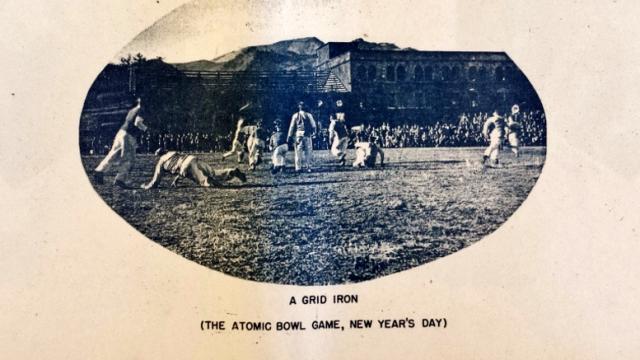The US and North Korea seem to be on the brink of starting a nuclear war almost every single day here in 2018. But even if a nuclear bomb is used and millions die, whatever humans left surviving will try to achieve some level of normalcy in the aftermath. How do I know that? In 1946, American troops played a football game in Nagasaki after dropping a nuclear bomb on it.
The United States became the first nation to ever use a nuclear weapon on August 5, 1945 when it dropped an atomic bomb on Hiroshima. And then it did so again on August 9, 1945 in Nagasaki, killing over 80,000 people in that city alone. But that didn’t stop the Americans from trying to turn Japan into a place they could enjoy after fighting had ceased. Even in a world that appears nothing short of apocalyptic, humans just want things to feel normal again.
The American occupation forces were understandably depressed about the death and destruction that surrounded them, even if they rationalized the use of the bomb as good and justified to stop the war. The footage taken in the following months by both American and Japanese cameramen was suppressed by the US military for decades, showing the carnage and the absolute misery of what had been unleashed on Japan.
American commanders tried to brainstorm a number of ways to lift the spirits of their troops, many of whom didn’t have much to do because the US military hadn’t expected them to survive beyond a few days of the invasion. So they put on a football game. But the “Atomic Bowl” as they called it had to be converted to two-hand touch. The reason? There was still way too much broken glass everywhere in the city.
The story of the ‘Atom Bowl’ is one of the most bizarre tales in the wake of the atomic bomb being dropped on Nagasaki, Japan – pitting the makeshift teams the Nagasaki Bears against the Isahaya Tigers. The Bears’ quarterback was Angelo Bertelli, who won the Heisman trophy in 1943 while playing for Notre Dame. Bertelli enlisted in the Marines in 1942 but wasn’t deployed until the fall of 1943. The Tigers had Bullet Bill Osmanski, an NFL star who played for the real life Chicago Bears and led the league in rushing in 1939 with 639.17m.
The Tokyo Files Archives has a photo from that day on January 1, 1946, taken from the “Pictorial Arrowhead Occupation of Japan by Second Marine Division,” — a yearbook of sorts for American troops in Japan. The photo is just one among dozens in the book that examine the destruction that was unleashed on that city.
Newspapers of the time also told the story of the roughly 2,000 servicemen and women who braved the winter cold to watch the Atom Bowl. A syndicated story in the January 2, 1946 edition of the Moorhead Daily News in Minnesota explained to Americans at home that our troops in Japan were keeping their spirits up with a football game:
Bill Osmanski, former Holy Cross and Chicago bears star, ran and kicked his “Nishshaya Tigers” to a 14-to-13 victory over Angelo Bertelli’s “Bears” in the first atom bowl football game today.
Several thousand servicemen and women huddled in the winter cold to watch the game on the Nagasaki gridiron, carved by marine from the dust and rubble of this atomic bomb target today.
Osmanski, a marine first Lieutenant, scored both touchdowns for the Tigers and booted both extra points — all in the second half — after navy Lieutenant Bertelli, former Notre Dame great and captain of the Bears, had passed his club to a 13-to-0 lead at halftime.
Back in 2005, the New York Times talked with one of the people who was there, Gerald Sanders, a Marine Corps Reserve colonel from Oxford, Ohio who was 81-years-old when the newspaper spoke with him. Just happy to be alive, Sanders said they saw nothing strange about putting on a football game in the charred remains of Nagasaki.
“We thought it would be totally appropriate and symbolic of a celebration,” Sanders told the New York Times. “It was certainly not to look like there was a joyful glee in what had happened there. It had an emotional effect on us. We were there, yet we had many buddies that didn’t make it through the war.”
Some curious Japanese civilians watched the game, “from behind the shells of scorched buildings,” as the New York Times put it. But most had other things to worry about, like the effects of radiation or finding a place to sleep.
Humans will always try to find some way to experience the familiar even in the middle of complete and utter devastation. But let’s just hope that we don’t need to see that kind of thing happen again anytime soon. With the unhinged rhetoric of both President Trump and Kim Jong Un we may see a second Atom Bowl within our lifetimes. But given how advanced nuclear weapons have become since 1945, they probably won’t be playing in San Francisco or Seoul or Tokyo. How’s Australia this time of year?
